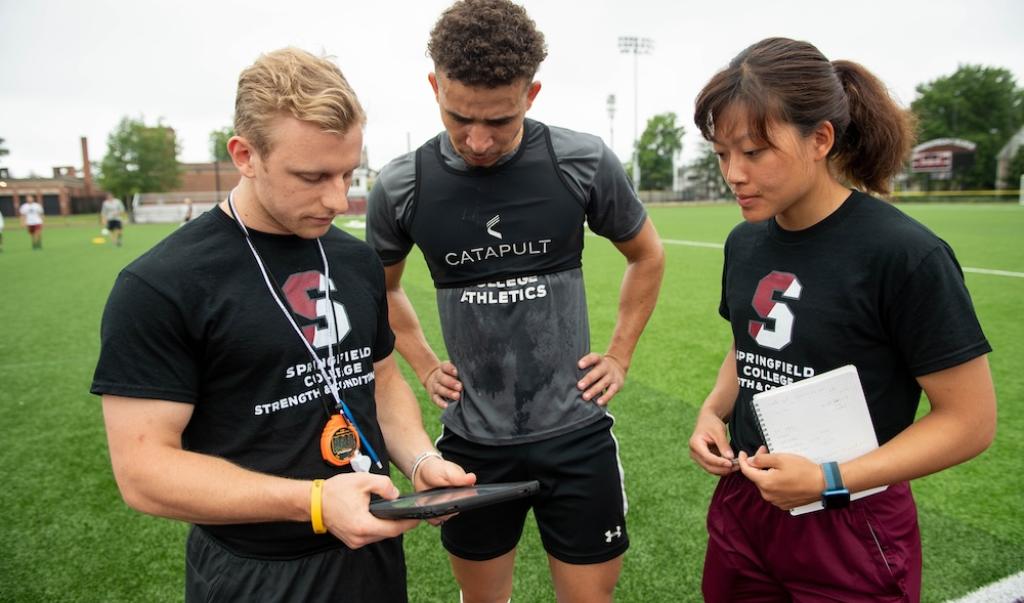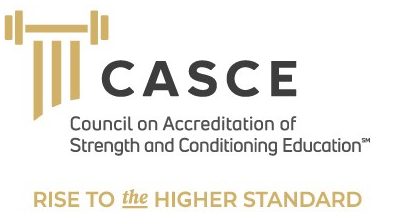Strength and Conditioning
| About This Program | |
|---|---|
|
Admissions Contact
Rachel Ahlmeyer Are you an International Student? |
|
|
Program Contact
Mary Kate Feit |
|
Curriculum and Delivery
|
|
Start Dates and Duration
|
|
| Graduate Success and Careers | |
| Paying for Your Education | |
|
Certified Strength and Conditioning Exam Pass Rate
Over a 90% first attempt Certified Strength and Conditioning Specialists passing rate. |
|
|
Deciding between sport science and strength and conditioning programs? We can help. |
|
|
Upcoming Events
Check back for upcoming events! |
|
|
Follow us on Instagram |
|

Take Athletes to the Next Level.
The MS in Strength and Conditioning at Springfield College prepares you to work with athletes as a strength and conditioning coach in secondary schools, collegiate and professional programs, and private settings. You will develop the skills and knowledge required to design physiologically sound programs that enhance athletic performance, as well as the coaching skills needed to implement the programs. To ensure you’re ready to hit the ground running when you graduate, you’ll complete multiple fieldwork experiences and study from a coursework that is relevant, practical, and based on research.
 The MS in Strength and Conditioning program is the first graduate program to receive accreditation by the Council on Accreditation of Strength and Conditioning Education (CASCE). CASCE accreditation signifies a commitment to the highest standards of excellence, credibility, professionalism, and safety for strength and conditioning students, educational institutions, Certified Strength and Conditioning Specialist (CSCS) professionals, and their athletes.
The MS in Strength and Conditioning program is the first graduate program to receive accreditation by the Council on Accreditation of Strength and Conditioning Education (CASCE). CASCE accreditation signifies a commitment to the highest standards of excellence, credibility, professionalism, and safety for strength and conditioning students, educational institutions, Certified Strength and Conditioning Specialist (CSCS) professionals, and their athletes.
How to Apply
Admission Requirements
- Complete the online application: Once your application form is processed you will receive an email with your application portal login credentials and instructions for submitting supplemental materials as listed below.
- Essay: In two to three double-spaced pages, please describe significant life experiences that have contributed to your interest in your field, your understanding of this field, your occupational objectives, and why you have chosen Springfield College.
- Resume: Please include any college activities, out-of-school leadership experiences, work history, and community involvement to support your interest in or qualifications for graduate study.
- Two letters of recommendation: Two letters of recommendation from a faculty member or direct supervisor: Recommenders will receive an email when you submit your application and will be able to upload your letter to your application.
- Transcripts: An official transcript from each college/university you have attended is required. In order to be considered official, transcripts must be received directly from the original source, by email to graduate@springfield.edu or mailed to the college address:
Springfield College
Office of Graduate Admissions
263 Alden Street
Springfield, MA 01109
International Applicants
- $100 non-refundable International Application fee
In addition to the above admissions requirements, all international applicants from non-English-speaking countries are required to submit:
- Proof of English language proficiency by way of the TOEFL or IELTS: Other tests may be accepted on a case-by-case basis. Please refer to our language requirements for more information on acceptable tests, minimum scores, exemptions, and conditional acceptance. If your undergraduate degree was earned in the United States and you successfully completed college-level English, we will consider English language proficiency met.
- Please note: Transcripts must be in English. If the transcript is not in English you will be required to submit a professional credential evaluation completed by any member of the National Association of Credential Evaluation Services (NACES). For this we recommend SpanTran, with its customized portal for Springfield College applicants. World Education Services or Josef Silny & Associates, Inc. are also recommended for your credential evaluations.
The Office of International Admissions can assist you with questions you may have about enrolling at Springfield College as an international student by emailing intladmissions@springfieldcollege.edu.
Application Deadlines
Domestic Students:
- Applications are reviewed on a rolling basis as space is available.
International Students:
- Application and Supporting Materials Deadline: May 1
